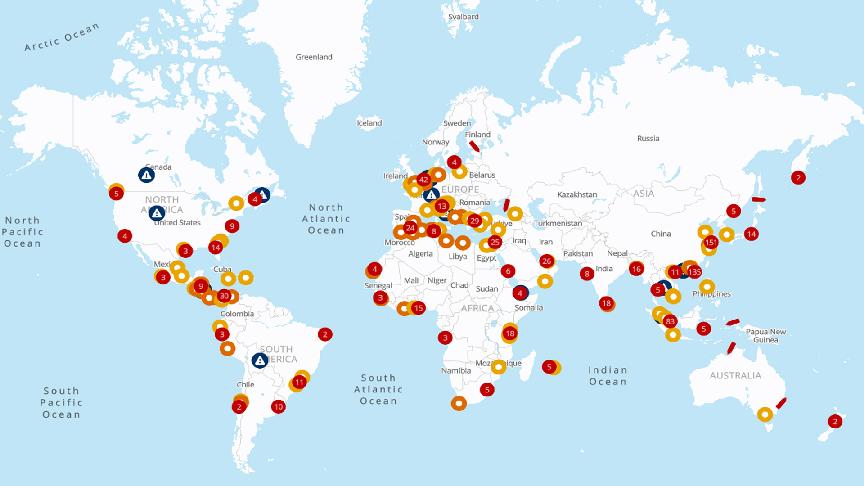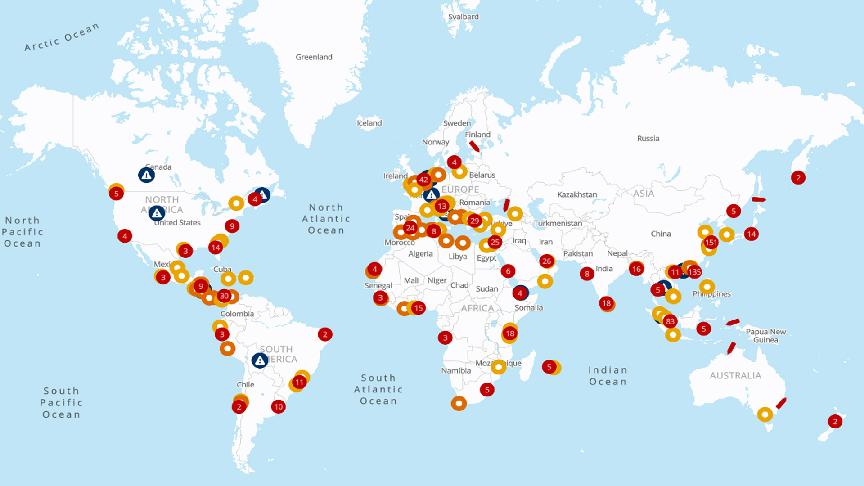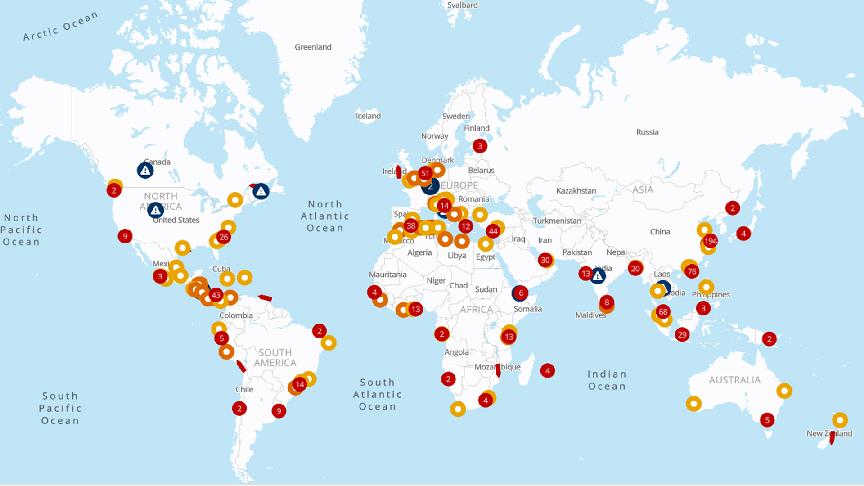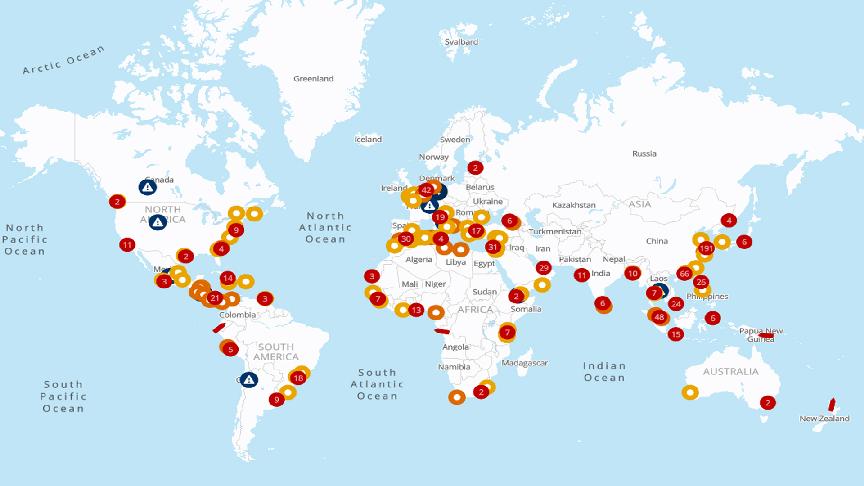- Stay ahead of supply chain disruptions and port congestion with Kuehne+Nagel’s weekly port operational update.
- Find out the latest vessel waiting times and status of ports in Africa, Asia Oceania, Europe, Middle East-Indian Subcontinent, North America, and South and Central America.
Africa

Kenya
Mombasa: The 7-day average vessel waiting time has improved this week. Port congestion and vessel bunching are resulting in berthing delays. According to seaexplorer, six ships were at anchor at the time of publication.
Ivory Coast
Abidjan: High yard density is resulting in lower productivity and berthing delays. Some carriers report waiting up to 7 days for a berth.
Morocco
Casablanca: The 7-day average vessel waiting time is around 3.88 days.
Tanger Med: Due to congestion, carriers report waiting times of up to 4 days. At TCT, carriers report waiting times of 5-6 days. The yard is congested due to an increase in discharge volumes from late-arriving vessels.
South Africa
Cape Town: Winter weather and strong winds intermittently interrupt port operations, increasing vessel waiting times. This week, strong winds are expected on Friday, 11 July. Planned terminal maintenance is taking place. No other disruptions were reported for Cape Town.
Durban: No issues related to terminal operations have been reported. Vessels berth on arrival at Pier 1. At DCT and Point Terminal, waiting time can be up to 1 day. Road rehabilitation along Bayhead Road may lead to some gate congestion.
Port Elizabeth: Eastern Cape ports are susceptible to disruptions due to winter weather. This week, high swells and strong winds are forecast for 11 and 12 July. At NCT, waiting time can be up to 1 day.
Tanzania
Dar Es Salaam: Road congestion and congestion at the terminal gate are causing container movements to be delayed. Adani terminal is undergoing maintenance works at the quay for the next two years. Seaexplorer showed four vessels waiting for a berth at the time of publishing.
Asia Oceania

Australia
Due to adverse weather in Fremantle and Sydney in week 27, vessel waiting times have increased to 2 days.
China
Fog closures and port congestion result in increased waiting times at Chinese ports. The number of waiting vessels at the Qingdao anchorage has risen to 54, and at the Shanghai-Ningbo anchorage, 124 vessels are waiting.
Malaysia
Port Klang: High yard utilisation, berth congestion, and vessel bunching have increased ship waiting times to 2.5 days. According to seaexplorer, 25 vessels are currently at anchor.
New Zealand
Auckland: Another low-pressure system is tracking southwest from the Tasman Sea, and is expected to bring high winds and heavy rain from Friday, 11 July, to Saturday, 12 July. Should the winds exceed safe working limits, operations will be halted at the port and empty yards.
Tauranga: Port operations in Tauranga were significantly impacted by adverse weather in week 27. The port lost 16 hours due to wind and 18 hours of vessel movements due to high swells. The weather is forecast to improve this week. More than 110 vessels are expected to arrive off their berthing window this week, leading to delayed departures. The port is still not accepting early gate-ins of export containers.
Singapore
Singapore: Carriers report berthing delays of 2+ days on average due to vessel bunching, off-schedule arrivals and delays at previous ports. Transhipment cargo dwell times can reach up to two weeks in some cases, dependent on vessel schedules and vessel space availability. LCL cargo does not experience any transhipment delays.
Thailand
Laem Chabang: Maersk reports ongoing trucking challenges due to congestion at Terminals A0 and B1. A sudden influx of import and export volumes, increased vessel calls, proforma moves, and operational constraints has resulted in extended truck turnaround times.
During week 28, the average turnaround time for import and export operations was 5 hours. This reached 6-7 hours during peak hours. For week 29, Maersk expects operations to return to near normal with a maximum turnaround time of 5 hours.
For import shuttling, the turnaround time between Laem Chabang and the Lat Krabang area (via truck and rail) has improved, averaging 3–5 days last week (week 27), and is expected to remain stable for the next two weeks.
Europe

Belgium
Antwerp:
- MEPT: The berthing lineup is busy, and yard density is around 75%. Due to the yard congestion, waiting times have increased for container pickup/dropoff. Labour shortages are expected during the summer holiday period.
- PSA:
- Q913: The berthing line up is full, and vessel service can wait 2-5 days or longer. Heat breaks are in effect at the terminal, allowing for 20-40 minutes per break. Labour shortages are expected over the summer holiday period and over weekends.
- Q869: The terminal is limited to one berth due to construction, impacting the berthing lineup. The yard is heavily utilised for both dry and reefers.
- Q667: No operational issues at the barge terminal.
Czech Republic
A massive power blackout in the Czech Republic shortly before 12:00 on 4 July halted rail traffic for most of the afternoon. Power was restored at around 17:00 the same day. As the situation stabilises, delays to rail cargo can be expected.
Germany
Rail closures
- Due to bridge construction, rail tracks serving Hamburg Container Terminals (CTH), also known as Eurogate, and Burchardkai (CTB) will be closed in August and October. In addition, the line between Berlin and Northern German ports will be closed from August 2025 until April 2026. Both closures would add further pressure to rail and truck services. Read more
Bremerhaven: The yard is around 85% full. A labour shortage is anticipated in July and August. Some vessels can wait up to 2.5 days.
Hamburg:
- CTA: The berthing lineup is full with a backlog created by heat disruptions, and yard density remains high due to longer container dwell times. Gate-in restrictions remain in place. A labour shortage is expected in July and August. A train backlog after the planned closure is delaying rail cargo.
- CTB: Carriers report average waiting times of 4 days at CTB due to a busy lineup and late-arriving vessels. Similar to CTA, gate-in restrictions remain in place and labour is expected to be tight over July and August.
- CTT: Late-arriving vessels face berthing delays. Yard density is high, and gate-in restrictions remain in place. The summer vacation period is expected to reduce labour in July and August.
Italy
Bari: The terminal is currently facing severe congestion due to disruptions in the vessel schedule, leading to long queues of truck drivers attempting to collect and deliver units.
Genoa: Some carriers report waiting times of up to 3.5 days. Due to the ongoing congestion, some vessels may omit Genoa. The yard density is around 84%.
Trieste: From 14 August 2025, 00:01 a.m. until 16 August 2025, 23:59, the train station in Trieste Campo Marzio will be closed due to construction works. This will result in complete railway closure, limiting the network. Alternative options would be all-motor.
Netherlands
Rotterdam:
- ECT: The average waiting time for mainline vessels at ECT is 2 days. Feeders and barges face longer delays. Yard occupancy is high. Truck congestion has been reported at peak hours. The lack of gangs impacts labour availability. ECT is restricting the maximum allowed ITT moves for feeders. Between ECT and Delta II, the accepting terminal is reviewing further restrictions. Mainliner-to-mainliner ITT is still being handled. Today, ECT Delta and ECT Euromax are experiencing a system outage, restricting landside operations, particularly the release of customs hold.
- RWG: Carriers report waiting times of 5 days at this terminal for late arrivals. Yard congestion is high due to high import volumes.
- MVII: Yard utilisation is high. On 1 July, operations were halted from 12:30 till 22:00 due to breakdowns of equipment caused by extreme heat. The backlog has been cleared.
- Delta II: ITT, barge and feeder challenges remain unchanged
Slovenia
Koper: The 7-day average vessel waiting time is around 1.75 days. Terminal utilisation is at 93%. The volume surge has resulted in import and export dwell time of 5-6 days. Railway reconstruction until 3Q 2026 reduces train traffic, causing an increase in truck traffic.
Spain
Algeciras: Carriers report a high yard density of around 86% and a full berthing lineup. The port prioritises heavy export vessels to combat yard congestion and keep operations fluid. Some vessels wait 2 days for a berth.
Valencia: At APMT, yard density remains exceptionally high at 90%. The terminal has advised that terminal stock levels have not yet been replenished and has requested that import containers be collected as a matter of priority. A second berth for mega ships has been added to the terminal, allowing it to service two ultra-large ships simultaneously.
United Kingdom
London Gateway Port: Due to recent power and system outages, productivity is currently lower. Berth dredging operations are ongoing, subject to availability, due to a fully occupied berthing schedule.
Southampton: The terminal is currently operating at 85% capacity, with reefer utilisation at 58%. Late-arriving vessels can wait up to 2 days. The yard occupancy is around 75%.
Middle East - Indian Subcontinent

Bangladesh
Chittagong: Heavy congestion shows no signs of easing as monsoon weather adds to delays. Read more
Sri Lanka
Colombo: Maersk reports that the onset of the monsoon season has increased congestion at the port. "Heavy rainfall and strong winds have disrupted terminal operations, causing berthing delays and increased yard density. These issues have affected vessel connectivity and cargo flow, resulting in delays to regional schedules."
Maersk says it is proactively diverting cargo where necessary and working with terminal operators to reduce delays. Other sources report that transhipment cargo can be delayed by 1-2 weeks in Colombo.
UAE
Jebel Ali: High temperatures can cause crane breakdowns and operational stoppages, reducing productivity by 5-10%.
North America

Canada
Average import rail dwell time for Canadian cargo (Vessel arrival to departure rail ramp):
- Halifax: 3 days
- Montreal: 8 days
- Prince Rupert: 5 days
- Saint John: 5 days
- Vancouver: 9 days
Mexico
Altamira: Export truck assignments require 48 hours and imports 72 hours. Planning of rail cargo requires 48 hours and 72 hours for imports and exports, respectively.
Manzanillo: Carriers report berthing delays of up to 4 days due to congestion and labour shortages. Export truck assignments require 48 - 72 hours, while import truck assignments require 72-120 hours. Planning of rail cargo requires 72 hours and 48 hours for imports and exports, respectively.
USA
Average import rail dwell and transit time for US cargo (Vessel discharge to destination ramp):
- Montreal: 10 days
- Prince Rupert: 12 days
- Vancouver: 14 days
- Charleston: 4 days
- Houston: 12 days
- Los Angeles: 9 days
- Long Beach: 8 days
- New York: 7 days
- Norfolk: 7 days
- Savannah: 4 days
Charleston: Carriers report waiting up to 3 days for a berth. At the time of publication, 3 vessels were at anchor.
New York/New Jersey:
At APMT, the last new crane on the East Berth is expected to be operational by the end of summer. The terminal is experiencing a high volume of gate appointment requests and may not be able to fulfil all of them, especially on vessel cut-off days.
It is recommended that customers deliver export cargo within the initial gate-in days, as more slots are generally available during this period.
South and Central America

Colombia
Cartagena: Late-arriving vessels and those exceeding move limits face delays. Delays to transhipment cargo have been reported. Peak agricultural season is adding pressure to land logistics.
Costa Rica
Caldera: The 7-day average vessel waiting time is around 2 days. The port is currently congested, and the infrastructure is unable to cope with the volume influx, leading to fluctuating levels of disruptions.
Puerto Moin: The APMT is experiencing significant congestion, causing difficulties in scheduling and coordinating shipments and delays in the movement of import and export containers. Customers may experience longer transit times and delays in receiving their shipments.
El Salvador
Acajutla: The 7-day average vessel time is around 10.5 days. Due to maintenance, vessels encounter substantial delays before commencing their operations. The yard is heavily congested, and there is a slight labour shortage, leading to longer turnaround times. There is a lack of trucker availability due to congestion and a trucker shortage. The departure of containers from the port is subject to trucking slot availability.
Guatemala
Puerto Santo Tomas de Castilla: The port is facing significant congestion and operational delays due to increased import and export volumes compounded by the ongoing reefer season. Additionally, the situation at the port has disrupted inland transportation. The entry of export equipment has been restricted due to limited capacity, and the retrieval of import containers has slowed considerably.
Honduras
Puerto Cortes: Carriers report waiting up to 7 days for a berth and departing the port with a week's delay. The port is challenged by a doubling of volume due to seasonal commodity increases, a high number of red-selective inspections, and limited customs personnel on-site.
For imports, 48 hours notice is required to manage and ensure container departure. Exports require a minimum of 2 weeks' advance notice. According to seaexplorer five vessels were at anchor at the time of publication.
Nicaragua
Corinto: The 7-day average vessel waiting time is around 1.33 days. Vessels can wait up to 10 days before operations begin at the port. The yard is congested.
How Kuehne+Nagel calculates the 7-day average vessel waiting time
Mainline container vessels may spend a certain number of days waiting at designated anchorage areas before their scheduled port call.
To calculate the 7-day average waiting time, we consider the waiting days of these vessels, excluding:
- Waiting times for feeder vessels,
- Idle ships without an announced next port,
- Slow steamers heading toward the anchorage but not actively waiting within the designated area
- Vessels passing through the anchorage area without intending to call at the port.
This rolling average is based on the data from the last seven days and is updated daily in seaexplorer.
To find the latest waiting time for a port, enter the port name or code in the search bar and select the relevant option.
Stay Ahead Stay Informed: Register for seaexplorer for the latest disruptions and vessel waiting times at global container ports.







